Are you a Quiet Speculation member?
If not, now is a perfect time to join up! Our powerful tools, breaking-news analysis, and exclusive Discord channel will make sure you stay up to date and ahead of the curve.
Those who don't learn from history are doomed to repeat it. So the old cliché goes, and frequently so it also goes in reality. Humanity has tread a lot of ground as a species, and a lot of situations repeat. Consequently, lessons from the past frequently apply to modern problems and should inform decision making. This goes for Magic too. The game is nearing 30 years old, and there have been thousands of tournaments and decks for players to learn from without having to build a deck and play it themselves. However, Magic's history is rather obscure. Almost all of it has been chronicled on the internet, and many of the websites from the early days are defunct. Even when that's not the case, it's hard for newer players to know if certain knowledge exists and look for it. That's where I come in.
In this case, I'm here to remind everyone that Yorion, Sky Nomad isn't doing anything new. I don't mean the creature itself, that's too obvious. Yorion's effect on Modern isn't really about his stats or ETB trigger. Yorion incentivizes players to play more than 60 cards in a way that nothing else has in a very long time. It's not the first time, but it is (as far as I could find) the first widespread implementation. This is not just in terms of decks where it's happening, but formats. However, there are problems emerging which the previous attempts had to deal with as well. And I don't think Yorion fixes all of them. Though it does fix some, kinda.
The Mathematical Basics
I'm no Frank Karsten; this article won't be a mathematical treatise. There are very good mathematical reasons to never play more than the minimum required given the rules of the game. There are many ways to get around the restrictions and beat the rules. So many that it would take an entire academic paper to accurately detail all of them and how they impact the real odds of a given outcome. 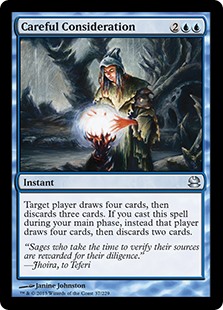 I idly speculate that someone's done that already because grad students have paper quotas to meet. In any case, I have neither the knowledge nor inclination to write an article detailing all the math around deck size. Nor is it strictly necessary.
I idly speculate that someone's done that already because grad students have paper quotas to meet. In any case, I have neither the knowledge nor inclination to write an article detailing all the math around deck size. Nor is it strictly necessary.
This is because regardless of the specifics of a deck's composition, the math will always begin the same way. Due to the restriction that in Constructed a deck may contain no more than four of any card (besides basic lands), the odds of seeing a given card start out as 4/x, where x is the number of cards in the deck at the start of the game. As a game progresses, cards are removed from the deck via drawing and tutor-type effects, meaning that the odds improve from there (and yes, hypergeometric calculations are necessary to actually determine those odds, but they're not necessary to understand my point). Therefore, all else equal, the best way to ensure that a specific card is drawn in a game of Magic is to start out with as small a deck as possible so that the odds of drawing it improve meaningfully faster. This means that as a rule, it is best to start out with a sixty-card deck in Constructed, with initial odds of 4/60=.0667 or 6.67% to pull a given card at random from the deck.
Consider an Extreme
Were deck minimums nonexistent, it would make no sense for any deck to play more than the bare minimum necessary to win the game. In such a world, a deck capable of winning on turn one only needs eight cards in total. It has a seven-card ideal hand and one more card so that it doesn't just deck on the draw. (Don't think about the setup too hard; this is a thought experiment.)
A deck playing more cards would always be at a disadvantage. More cards means that it doesn't always see its (nearly) ideal hand because the odds are less than the (7/8)=87.5% afforded by the eight-card deck. The certainty of an ideal start almost certainly trumps the larger deck's ability to recover if they're disrupted.
Improving the Odds
The same logic applies to all Magic formats. The decks that adhere closer to their minimum requirements are more likely to hit their ideal hands and are therefore more likely to achieve their ideal gameplans. However, as mentioned, there are many ways to improve those odds, regardless of deck size.
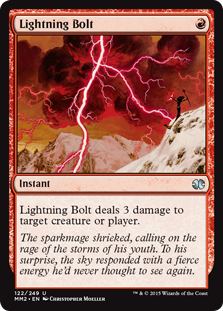 The first way is to break the Rule of Four. I don't mean doing that literally; that's how you get DQ'd and banned. Rather, play many cards that do the same thing. This was the biggest innovation of Extended Red Deck Wins way back in 2002. When every card does essentially the same thing, it doesn't matter what specific card is drawn, improving deck consistency.
The first way is to break the Rule of Four. I don't mean doing that literally; that's how you get DQ'd and banned. Rather, play many cards that do the same thing. This was the biggest innovation of Extended Red Deck Wins way back in 2002. When every card does essentially the same thing, it doesn't matter what specific card is drawn, improving deck consistency.
The second option is the Turbo Xerox approach. Playing cards that draw cards force a deck to shrink and the odds of finding specific cards to increase. The stronger the cantrip, the greater the effect. Tutors take this principle and supercharge it, which is why so few are competitively priced anymore.
History Lesson
All that said, since the invention of Magic players have fought the basic math and have in fact put more than the minimum number of cards into their deck. In the earliest days it was because everyone was a scrub and deck optimization didn't exist. However, past that point decks quickly adopted the 60-card limit. But not all decks.
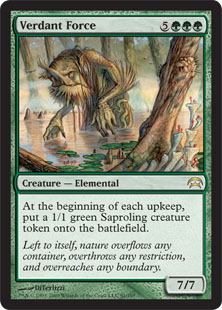 The first dedicated objection to the limit came from the Wakefield School. Jamie Wakefield and his disciples insisted on playing 26 lands in 62-card decks for several reasons. Ostensibly, it was so that they always had the mana to cast fatties (which was their entire purpose). The 26/62 ratio produced a solid 42% land deck where 26/60=~43% was prone to flooding. The more subtle reason was that it let the mana be more flexible to accommodate Wasteland and other mana denial cards. And in early competitive Magic, the strategy worked. However, as strategies evolved, the Wakefield school (and all the early schools, to be fair) became outdated and vanished.
The first dedicated objection to the limit came from the Wakefield School. Jamie Wakefield and his disciples insisted on playing 26 lands in 62-card decks for several reasons. Ostensibly, it was so that they always had the mana to cast fatties (which was their entire purpose). The 26/62 ratio produced a solid 42% land deck where 26/60=~43% was prone to flooding. The more subtle reason was that it let the mana be more flexible to accommodate Wasteland and other mana denial cards. And in early competitive Magic, the strategy worked. However, as strategies evolved, the Wakefield school (and all the early schools, to be fair) became outdated and vanished.
Still, that wasn't the end of big decks. There have been many attempts to play more than 60 cards in Constructed for a great many reasons. Which Frank Karsten detailed here, so I won't go into it. What I will expand on is that the most common reasons to play more than 60 cards has been to avoid drawing certain cards or to make sure you have enough of a certain card in your deck. Which has led some to utilize that to hybridize decks in the past. However, they've never stuck.
What Yorion Changes
And yet, for the past year-and-a-half, 80-card decks have been a thing in Standard, Pioneer, Modern, and Legacy. This is the longest period with the highest number of non-60-card decks I was able to find in the history of competitive Magic. It has nothing to do with any shifts in thinking nor a specific change in the essential math. The only reason it's happened is the printing of Yorion, Sky Nomad. That companion changed the incentives enough for bigger decks to work.
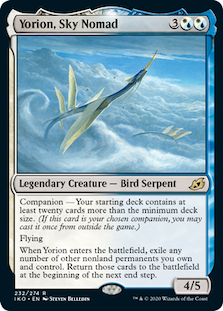 Having a companion means having a specific card guaranteed in any matchup. This means that whatever else a deck might do in a game, there is a specific payoff waiting for them. This is incredibly valuable for larger decks because it ensures that they will always do something. One of the biggest problems with big deck has always been the risk that insufficient action, or the wrong type of action, is drawn. Yorion removes this concern, and that alone reduces the risk of the big deck.
Having a companion means having a specific card guaranteed in any matchup. This means that whatever else a deck might do in a game, there is a specific payoff waiting for them. This is incredibly valuable for larger decks because it ensures that they will always do something. One of the biggest problems with big deck has always been the risk that insufficient action, or the wrong type of action, is drawn. Yorion removes this concern, and that alone reduces the risk of the big deck.
Of course, if that was the only benefit from Yorion, I doubt that it would be enough. Fortunately, Yorion is a mass flicker card. This means that there is a ton of value to be extracted by casting it. Thus a deck that is already inclined to play lots of ETB creatures doesn't just have a payoff with Yorion, it has a huge one. Big decks get a big payoff, and they've stuck around and been successful in a big way.
Improving Piles
Well, one type has been successful. Check the decklist archives I linked in the previous section. Notice a pattern? The vast majority of the deck across formats which employ Yorion as a companion (and occasionally maindeck) are piles. That isn't me being disparaging. Pile is a technical name for a deck with minimal- to non-existent synergy which instead simply plays  all the best cards in its color combinations. The plan is to out-power opponents with more of the best cards. This strategy benefits enormously from Yorion's existence. And not just because it's another fatty.
all the best cards in its color combinations. The plan is to out-power opponents with more of the best cards. This strategy benefits enormously from Yorion's existence. And not just because it's another fatty.
Rather, Yorion lets the piles become... piley-er? More pile like? A larger pile? Not sure of the proper terminology here and it may just be piling on [editor's note: readers, please don't go] but hopefully the point is coming across. Yorion just takes the pile and makes it more of a pile, increasing its piley power. Pile decks need lots of mana smoothing, cantrips, and other value to function. Yorion rewards the pile by letting it get another crack at all its cantrip permanents and value plays. The two synergize perfectly while not dramatically impacting consistency because in a pile every card is basically interchangeable.
The Unspoken Reason
As for the other decks, it's too broad a category to really get into. However, many of them are doing Yorion for the same reason that Death and Taxes frequently does: you can play with more of your cards. As a DnT player, there are a ton of cards that I really want to play but can't because there isn't space and/or they don't synergize with the specific attack strategy I'm using. Yorion's 80-card minimum means that now I can. And it's really fun. And sometimes, that's all the reason anyone needs.
Why Yorion Cascade Isn't Working
However, just because a deck is vaguely pileish and wants to manipulate its mana ratios and deck math doesn't mean that it will benefit from Yorion. Case in point: the Yorion version of Cascade Crashers is doing much worse than the 60-card version. At the end of October, Yorion Cascade was getting quite a bit of attention and seemed to be a solid deck. However, the data doesn't agree. As of writing this, 60-card Cascade Crashers is on pace for Tier 2 standing while I've recorded exactly one 80-card version. And it's happening for all the predictable reasons.
Math Strikes Back
The stated reason for going for the 80-card version was to improve the odds of hitting the ideal curve for Cascade Crashers. I realize that sounds strange given everything I said at the top of this article, but it does make mathematical sense. See, the best thing that the deck can do (it is the namesake after all) is play a cascade spell into Crashing Footfalls on turn 3. 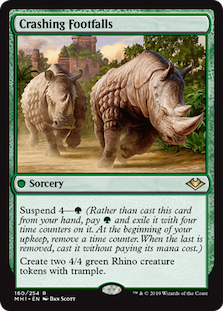 The normal version plays 2 cascade spells for starting odds of 8/60=13.3% to draw the cascade spell. With 80 cards, they have the space for the mana to play another cascader (normally Ardent Plea) and the odds get better at 12/80=15%. More importantly, the risk of the worst outcome (drawing Footfalls) gets lower from 4/60=6.67% to 4/80=5%. That's not a small improvement all around.
The normal version plays 2 cascade spells for starting odds of 8/60=13.3% to draw the cascade spell. With 80 cards, they have the space for the mana to play another cascader (normally Ardent Plea) and the odds get better at 12/80=15%. More importantly, the risk of the worst outcome (drawing Footfalls) gets lower from 4/60=6.67% to 4/80=5%. That's not a small improvement all around.
The problem is that the math for everything else has gotten worse. Yes, Yorion Cascade plays more good spells and Omnath, Locus of Creation is a very powerful and versatile card. However, it's far less likely that players will ever actually see said more powerful cards, and Cascade can't play all the cantrips to make up for this weakness. Piles work because they can play lots of cheap spells, particularly mana fixing, so that they can survive to cast the powerful spells. Because the whole point of the deck is ensuring a cascade into Footfalls, Crascade Crashers can't play cheap spells. It gets around that with free spells and Fire // Ice, but beyond that, really struggles with being clunky.
It Gets Worse
The problem gets worse after sideboard. Sideboard cards tend towards being critical after 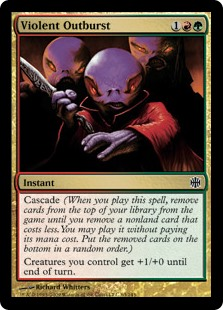 board and there really isn't a way to double up on them to improve the math. I've watched a lot of Yorion Cascade players at FNM and MTGO lose helplessly as they fail to draw the right spells at the right time and just die.
board and there really isn't a way to double up on them to improve the math. I've watched a lot of Yorion Cascade players at FNM and MTGO lose helplessly as they fail to draw the right spells at the right time and just die.
They had plenty of spells that were quite powerful in hand, but they were lacking either the mana to cast them or said spells didn't do anything. Lacking many ways to smooth their draws and cheap spells to catch up with, they were relegated to hoping that their individually powerful spells will be enough to pull them through. And unfortunately, raw power isn't good enough. Raw power with lots of support, on the other hand, works. In the pile decks.
The Inescapable Problem
Yorion Cascade is suffering from the exact same problem that all earlier attempts to use larger decks to improve the math of specific effects have throughout Magic's history. By increasing their deck size to improve specific math, they're making the rest of their math worse. Bigger decks work as Yorion piles, but not Yorion combos. And maybe that's good enough.





